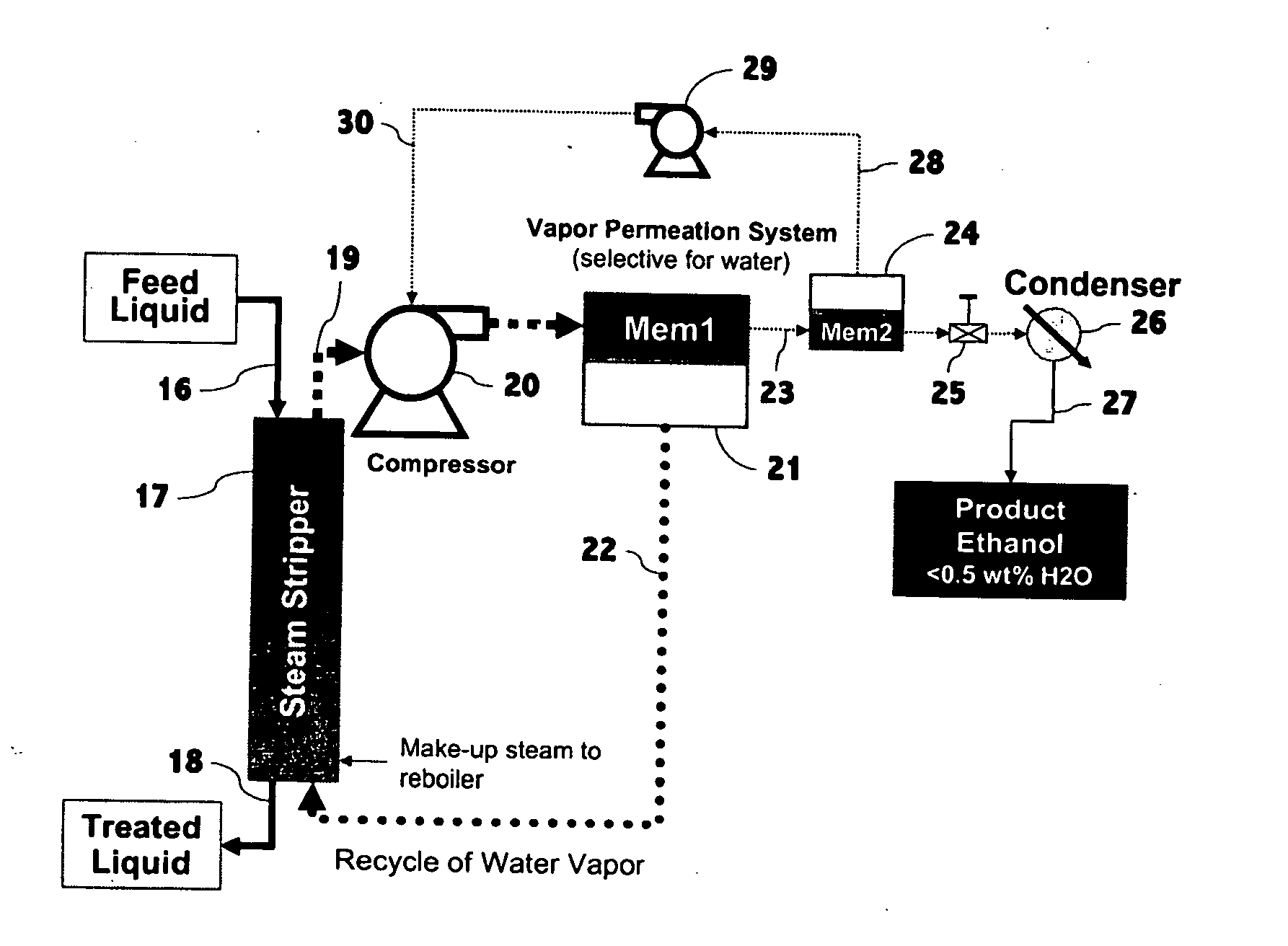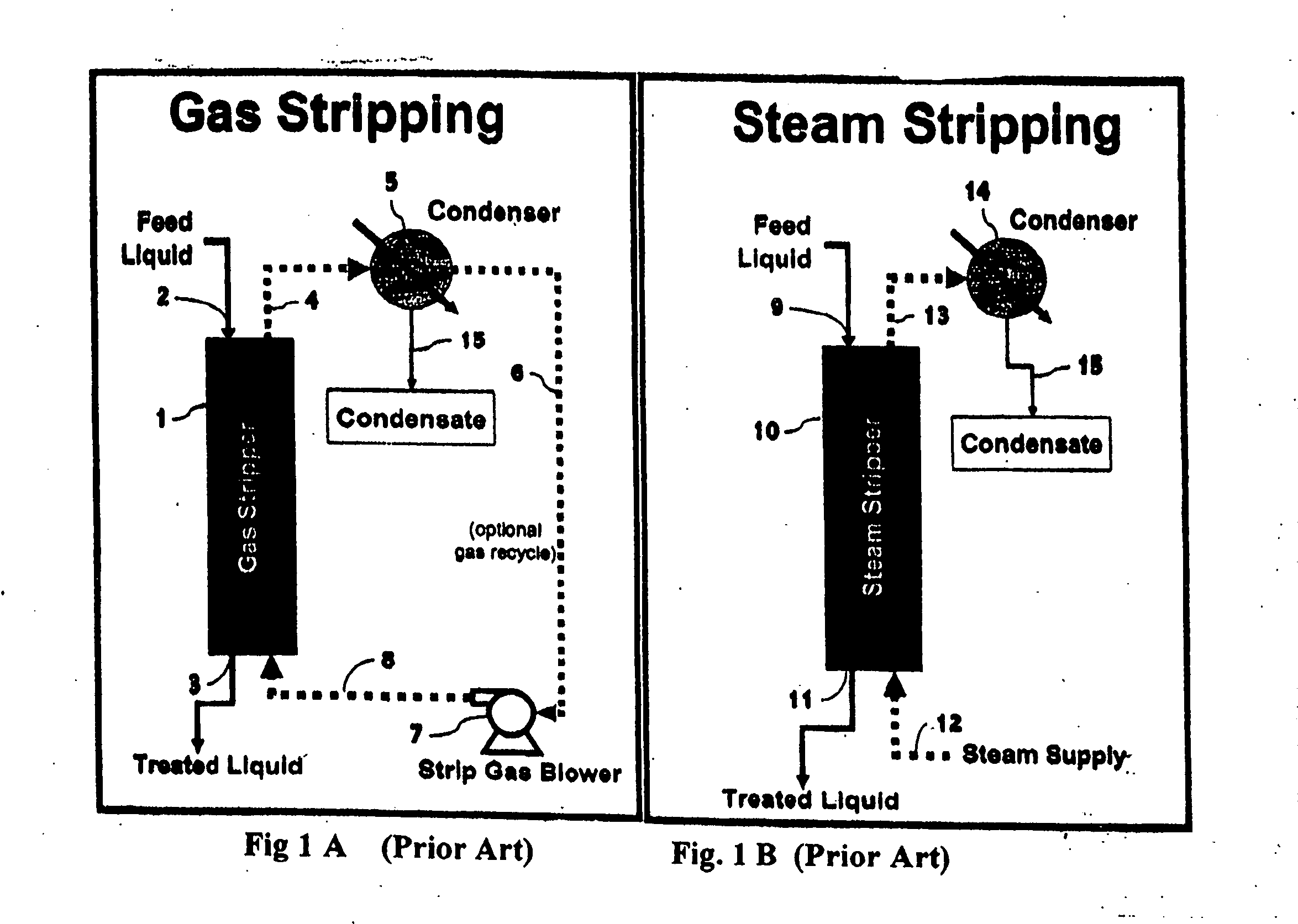Liquid Separation by membrane assisted vapor stripping process
a technology of vapor stripping and liquid separation, which is applied in the direction of membranes, vacuum distillation separation, separation processes, etc., can solve the problems of reducing stripping and overall separation efficiency, reducing standard distillation, and unable to reach standard distillation
- Summary
- Abstract
- Description
- Claims
- Application Information
AI Technical Summary
Benefits of technology
Problems solved by technology
Method used
Image
Examples
example 1
Effect of Non-Condensable Gas on Vapor Stripper, Compressor, and Membrane Systems
[0086]As noted previously, the use of non-condensable gases to strip organic compounds from water followed by the recovery and reuse of the gas has been taught in prior art. In order to test whether the absence of non-condensable gases is advantageous according to the present invention, the efficiency and cost of the compressor and membrane systems required in the process for a hypothetical overhead vapor as a function of non-condensable gas content were estimated. The ethanol-water binary mixture was chosen as the model system. The chemical process simulation program ChemCAD 5.4 (ChemStations, Houston, Tex., USA) was used to perform steady state calculations. ChemCAD was also used for most equipment sizing and costing. Exceptions were liquid pumps, liquid storage tanks and distillation / stripping towers, for which literature sizing / costing relationships were used. Column height was based on an assumptio...
example 2
Production of Fuel-Grade Ethanol from Dilute Fermentation Broths
[0097]The energy usage and capital / operating costs according to the present invention were estimated for the recovery of ethanol from aqueous fermentation broths containing 1 or 5 wt % ethanol. The schematic diagram of the standard configuration of the present invention considered in this example is shown in FIG. 5, which is a schematic diagram of a process according to the present invention in which permeate from the first membrane stage is returned as vapor to act as stripping vapor in the stripping column. Permeate from second stage membrane is directed to the suction side of the overhead compressor. Retentate vapor is optionally condensed by heat exchange with the reboiler.
[0098]Referring with particularity to the drawings, in FIG. 5 there is the feed liquid stream, 43, which feeds into the stripping column, 44. A stream of bottoms liquid or treated liquid, 45, exits the bottom of the stripping column. Said bottoms ...
example 3
Effect of Stripper Pressure and Compressor Discharge Pressure on Energy Usage
[0124]In example 2, the calculated energy benefits of the present invention relative to that of distillation were presented for the separation of ethanol / water mixtures. In that example, the operating temperature of the stripping column for the present invention was fixed at 55° C. In this example, the effect of stripper temperature (which determines the stripper pressure) and of the overhead compressor discharge pressure (which is the same as membrane feed pressure in the present invention) on energy usage for the present invention are calculated for ethanol-water mixtures of 1 and 5 wt % ethanol. The general basis assumptions are the same as those in Example 2 and generic schematic diagrams for the 2- and 3-membrane systems for this example are the same as those in Example 2 and are presented in FIGS. 5 and 11.
[0125]Raising stripper operating temperature also raises the operating pressure of the stripper,...
PUM
| Property | Measurement | Unit |
|---|---|---|
| energy | aaaaa | aaaaa |
| energy | aaaaa | aaaaa |
| permeable | aaaaa | aaaaa |
Abstract
Description
Claims
Application Information
 Login to View More
Login to View More - R&D
- Intellectual Property
- Life Sciences
- Materials
- Tech Scout
- Unparalleled Data Quality
- Higher Quality Content
- 60% Fewer Hallucinations
Browse by: Latest US Patents, China's latest patents, Technical Efficacy Thesaurus, Application Domain, Technology Topic, Popular Technical Reports.
© 2025 PatSnap. All rights reserved.Legal|Privacy policy|Modern Slavery Act Transparency Statement|Sitemap|About US| Contact US: help@patsnap.com



